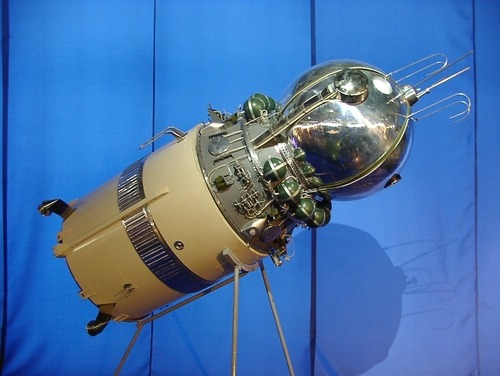Stubborn-turtle-blog
More Posts from Stubborn-turtle-blog and Others

Voskhod-the first multiple-manned mission
Although we now take for granted the long term success of the International Space Station, it wasn’t too long ago that we were totally earthbound. That changed on this day, October 12, 1964 when the Soviet Union launched the Voskhod 1 (Восхо́д), the first manned capsule to carry more than one person into space. The Voskhod program was a proof of concept program to test systems for more ambitious space exploration. The Voskhod program was notable for several firsts: the first multi-person mission to space (Cosmonauts Komarov, Yegorov and Feoktistov in the Voskhod 1) and the first space walk (Belyayev and Leonov in Voskhod 2). The Vostok and Voskhod programs provided the framework for what became the Soyuz program and ultimately the current ISS.

The Russian desire to ‘win’ the Space Race led to many dangerous compromises. The interior of the capsule (shown above) was so cramped that the cosmonauts would not have room for space suits, making the flight extremely dangerous in the event of depressurisation. To insure the engineers paid enough attention to this, head designer Sergei Korolev assigned the lead engineer to fly inside the capsule, therefore motivating him to design the safest capsule possible.

The Russian word Voskhod (Восхо́д) means sunrise and is a combination of the Russian words vos- (from vostok восток) meaning east and xodete (ходить) meaning go or rise.

Forms of government in 2016









Don’t try this at home!
I talked about the interesting structure of graphite (aka pencil lead) in our latest video:
But I didn’t have time to touch on one of the fascinating side effects of this structure - graphite’s conductivity. A single, two-dimensional sheet of graphite (known as graphene) is the most conductive material we know about. Diamond is among the least conductive materials we know about.
Impure graphite - like the stuff we find in pencils - is somewhere in between. It’s more conductive than sea water and less conductive than steel. As free electrons flow through it, it lights up like a filament and puts out a lot of heat.
Some risk-taking YouTubers (MausolfB Education and ElectroBoom) demonstrated this property so you don’t have to.
Diamond photo credit: Macroscopic Solutions, Graphite photo credit: DerHexer

Mason gives a startling example of the decline of car-wash robots, to be replaced by, as he puts it “five guys with rags”. Here’s the paragraph that really made me think:
“There are now 20,000 hand car washes in Britain, only a thousand of them regulated. By contrast, in the space of 10 years, the number of rollover car-wash machines has halved –from 9,000 to 4,200.”
The reasons, of course, are political and economic and you may or may not agree with Mason’s diagnosis and prescription (as it happens I do). But de-automation – and the ethical, societal and legal implications – is something that we, as roboticists, need to think about just as much as automation.
Several questions come to mind:
are there other examples of de-automation? is the car-wash robot example atypical, or part of a trend? is de-automation necessarily a sign of something going wrong? (would Mason be so concerned about the guys with rags if the hand car wash industry were a well-regulated industry paying decent wages to its workers, and generating tax revenues back to the economy?)

"There’s a certain aesthetic attached to the oldest cities in the world: bustling souks beneath a bright blue sky, flowing garments made of whispery white cotton, stone masonry painted yellow by the sun."
I dance the Waltz to look refined. I dance Salsa to look exotic. I dance the Tango to look sexy. I dance Blues to look sexual. I dance West Coast Swing to look smooth. And I dance Lindy Hop so I can stop worrying what I look like and just have fun bouncing and swirling like a deranged yo-yo.
If This Isn’t From a Book, It Should Be (via gaircyrch)
I’d argue that Westie looks like what ever you want it to be (I dance it because I love how free I feel)
Women need to be able to nurse, and pump, without shame when they return to their work.

Alarming disparities in health outcomes could be prevented by breastfeeding
A new study published in the Journal of Pediatrics showed that black infants had more than twice the deaths of whites attributable to lack of optimal breastfeeding. Black infants also had more than three times the rate of necrotizing enterocolitis, a devastating disease of preterm infants, attributable to suboptimal rates of feeding with their mother’s own milk.
White women initiate breastfeeding at much higher rates than black women and slightly higher rates than Hispanic women; moreover, white women breastfeed longer and have higher rates of exclusive breastfeeding. Current rates for black, white, and Hispanic women were defined as “suboptimal breastfeeding.” This is the first study to show how these disparities translate into differences in health outcomes.
“If mom can’t go to work, she’s not getting paid. This may spell the difference between making rent that month, or keeping the lights on, or paying for basic needs,” said Dr. Melissa Bartick, assistant professor of medicine at Cambridge Health Alliance and Harvard Medical School, and lead author of the study. “When I first saw our results, I cried.”
Melissa C. Bartick, Briana J. Jegier, Brittany D. Green, Eleanor Bimla Schwarz, Arnold G. Reinhold, Alison M. Stuebe. Disparities in Breastfeeding: Impact on Maternal and Child Health Outcomes and Costs. The Journal of Pediatrics, 2016; DOI: 10.1016/j.jpeds.2016.10.028
It is recommended that women breastfeed each child exclusively for the first six months of life, followed by continued breastfeeding while complementary foods are introduced for at least the first year of life. Credit: © gamelover / Fotolia
It's only coming out in German this weekend, but wow this looks cool.
-
 pubniche liked this · 8 years ago
pubniche liked this · 8 years ago -
 stubborn-turtle-blog reblogged this · 8 years ago
stubborn-turtle-blog reblogged this · 8 years ago
Gaming, Science, History, Feminism, and all other manners of geekery. Also a lot of dance
243 posts















